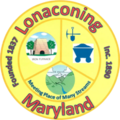2010 census
As of the census [10] of 2010, there were 1,214 people, 463 households, and 303 families living in the town. The population density was 2,961.0 inhabitants per square mile (1,143.2/km2). There were 525 housing units at an average density of 1,280.5 per square mile (494.4/km2). The racial makeup of the town was 98.1% White, 0.3% African American, 0.2% Asian, and 1.4% from two or more races. Hispanic or Latino of any race were 0.5% of the population.
There were 463 households, of which 30.9% had children under the age of 18 living with them, 47.3% were married couples living together, 13.4% had a female householder with no husband present, 4.8% had a male householder with no wife present, and 34.6% were non-families. 31.1% of all households were made up of individuals, and 15.6% had someone living alone who was 65 years of age or older. The average household size was 2.48 and the average family size was 3.08.
The median age in the town was 40.5 years. 23.8% of residents were under the age of 18; 8.3% were between the ages of 18 and 24; 24.3% were from 25 to 44; 22.9% were from 45 to 64; and 20.5% were 65 years of age or older. The gender makeup of the town was 47.2% male and 52.8% female.
2000 census
As of the census [11] of 2000, there were 1,205 people, 482 households, and 290 families living in the town. The population density was 2,875.8 inhabitants per square mile (1,110.4/km2). There were 559 housing units at an average density of 1,334.1 per square mile (515.1/km2). The racial makeup of the town was 98.67% White, 0.66% African American, 0.08% Pacific Islander, 0.08% from other races, and 0.50% from two or more races. Hispanic or Latino of any race were 0.50% of the population. At 16.1 percent Scottish, Lonaconing is the most Scottish town in the United States.
There were 482 households, out of which 28.0% had children under the age of 18 living with them, 46.9% were married couples living together, 10.0% had a female householder with no husband present, and 39.8% were non-families. 36.1% of all households were made up of individuals, and 21.8% had someone living alone who was 65 years of age or older. The average household size was 2.37 and the average family size was 3.15.
In the town, the population was spread out, with 23.9% under the age of 18, 8.1% from 18 to 24, 25.9% from 25 to 44, 19.5% from 45 to 64, and 22.6% who were 65 years of age or older. The median age was 38 years. For every 100 females, there were 83.7 males. For every 100 females age 18 and over, there were 75.0 males.
The median income for a household in the town was $27,434, and the median income for a family was $37,083. Males had a median income of $27,315 versus $19,423 for females. The per capita income for the town was $13,890. About 12.8% of families and 19.6% of the population were below the poverty line, including 30.3% of those under age 18 and 17.7% of those age 65 or over.






